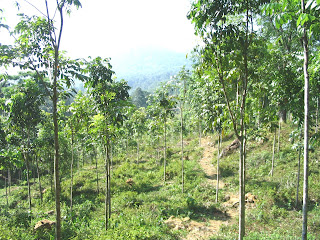Abstract of the presentation of
Sanomi Perera
Ceylon Satinwood which consist several local names such as
Buruta, Mutirai, Satinwood is categorized under Meliaceae family according to
Bentham and hooker classification system. Chloroxylon
swietenia is categorized under luxury class under timber class of STC.
It is a very large, slow growing deciduous tree with a
rather shorter bole and a spreading light feathery crown. The moderate height
is about 15-21m with a cylindrical stem which grows up to a dbh of 97cm. The
wood is hard and heavy and very durable and it has been used for sleepers and
has wide variety of uses such as doors, windows, flooring, furniture, carpenters
tools etc.
Management objective of Lanka Satinwood (PVT) Ltd. is to
maximise the land utilisation in a sustainable way while providing best quality
satin timber. The vision is to give a helping hand to save our forests and the
mission is to meet the demand for satin wood in Sri Lanka.
Land selection will be done based on the rain fall,
temperature, soil factors and labor requirements so a land in dry zone of 50 ha
in Puttalam district in the north central province will be selected. After
demarcation of boundaries and clearing planting of materials will be done. The
land will be utilized batch wise.
Stumped plants will be planted due to the high survival rate
so stumps will be prepared from plants about 2 years old in the nursery.
Spacing will be 3m ´ 3m
and a live fire belt will be established. Fertilizing will be done every year
until 15th year, weeding will be done for all 45 years and watering
will be done by a drip irrigation system. Pruning will be carried out by age 8
years and thinning will be done at three stages and they will be 15th,
25th and 35th ages.
Several kinds of damages can be expected towards the
plantation and some of them will be damages from wild boars, Teak defoliator,
Longicorn beetle. So necessary actions will be taken against pest and disease
problems if any was sensed. 30 labors will be taken, 5 security guards and one
technical officer will be included.
Extraction will be done at 45 years by providing more
favorable conditions though the rotation age of Satin is 70 years. Harvesting
method will be clear cut system. Aim is to achieve logs at harvest approximately
8m in length and 25 – 29cm of dbh with minimal taper and knots.
Inter cropping and other agro forestry practices will be
followed. The carbon sequestration potential of this plantation will be an
added benefit and we will be obtaining forest certification which will be a
value addition to our product.






